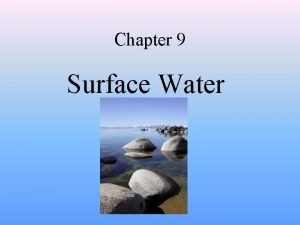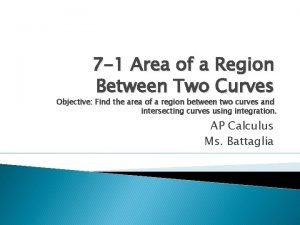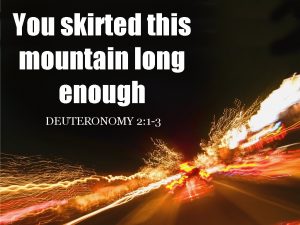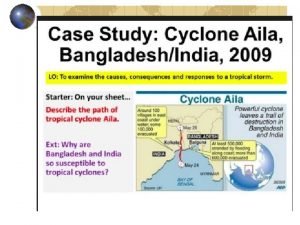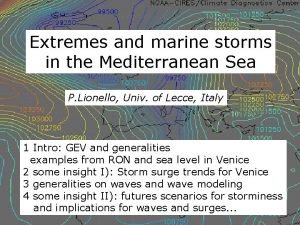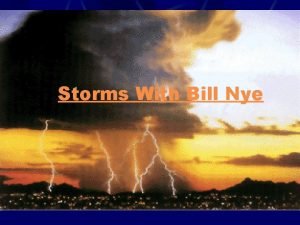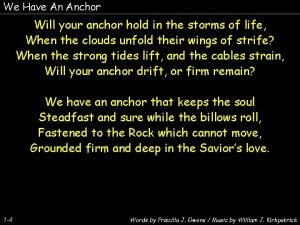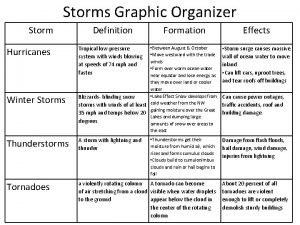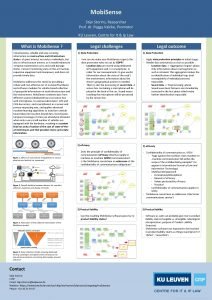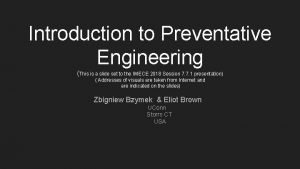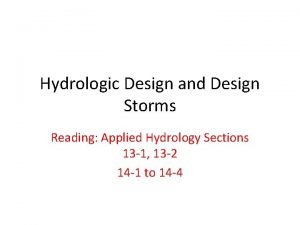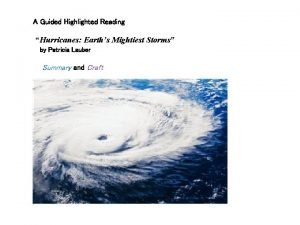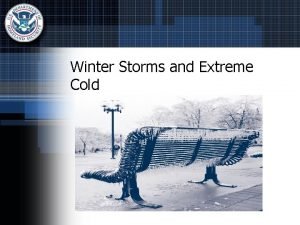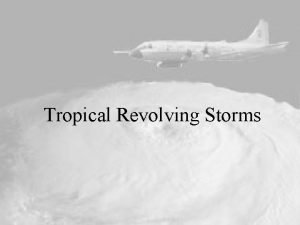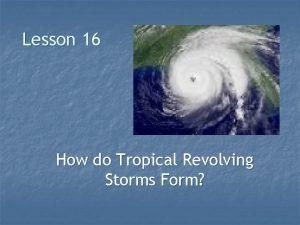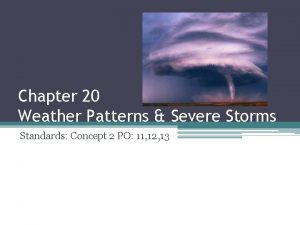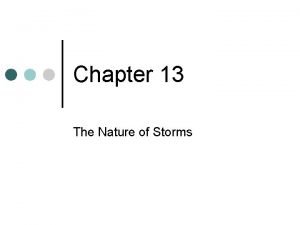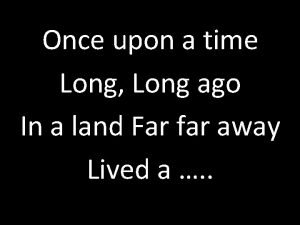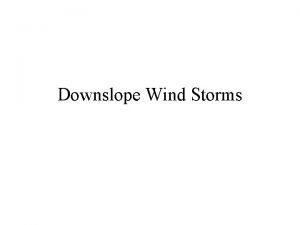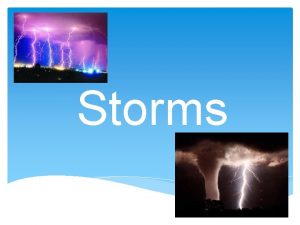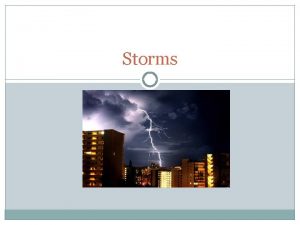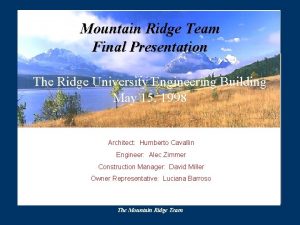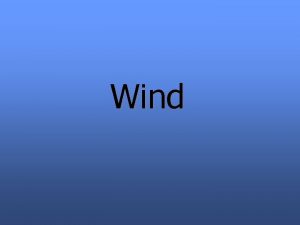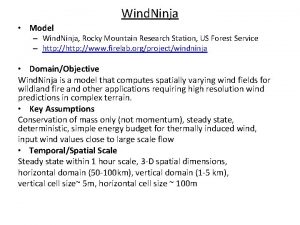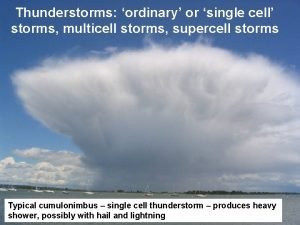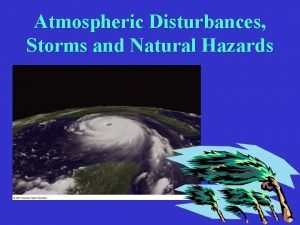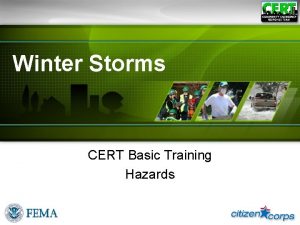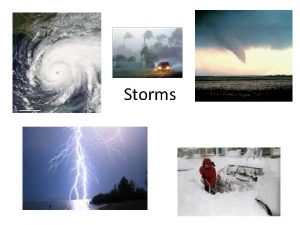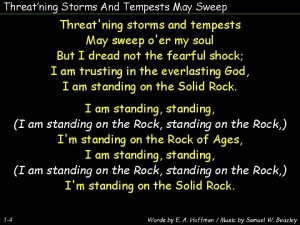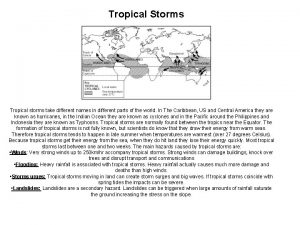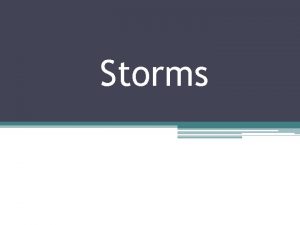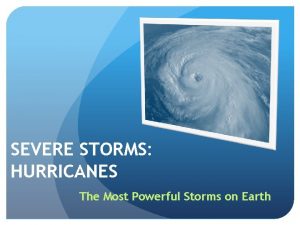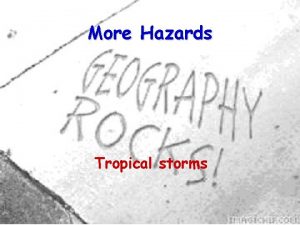Downslope Wind Storms Flow Mountain Ridge Infinitely long



















































- Slides: 51

Downslope Wind Storms

Flow Mountain Ridge • Infinitely long mountain, no flow around ridge • Consider first an airplane wing:

• Flow accelerates over the top of the wing in order to keep up with flow along shorter path under the wing • Bernoulli relationship tells us pressure must be lower at top of wing:

Small Ridge • Similar to airplane wing:

Meso-Beta Scale Ridge • Gravity response is involved, low pressure shifts down wind more as the scale of the ridge becomes larger:

Witch of Agnesi Ridge • Lets consider a “Witch of Agnesi”, bell shaped mountain (normally used for analytical mountain wave studies) having the formula: – a is the half-width, h is the maximum height, and d is the distance from the ridge top, and z_s is the topography height.

More about Witch of Agnesi • Easy for analytical solutions • NOT a sine wave, is a bell shaped ridge that contains a spectrum of wave components representing many wavelengths • Some parts of the ridge may be at super Rossby radius scale and some may be at sub -Rossby radius scale for instance

Froude Number • Important influences on atmosphere response to flow over an object: – (a) Length scale of the object – (N) Brunt-Vasallai frequency, the vertical stability providing a restoring force for gravity waves: – (U) velocity of flow normal to the ridge

Froude Number • Define Froude Number:

Inertial Cutoff, ie Rossby Number • The coriolis parameter is another important parameter. If the mountain is big enough, we get lee cyclogenesis, not gravity waves! So we must consider the Rossby Number, ie:

Flow Over a Ridge • We consider flow over shallow (h << depth of troposphere) ridges of several half-widths and look at the results of a linear analytical solution for the Witch of Agnesi mountain. • The solution to the linear problem yields a wave equation of the form: w- vertical velocity z- height above surface k – vertical wave number l – Scorer Parameter

Vertical Wave Number • L_x is the horizontal wavelength of the gravity wave. This parameter in the vertical wave equation is purely nonhydrostatic!

Scorer Parameter • This parameter is related to the transmissivity of the atmosphere to gravity waves considering only hydrostatic processes

When Gravity Waves? • Gravity wave solutions only exist when • Therefore, there is a “short wave cutoff” scale, below which gravity waves cannot exist: – L_z is the vertical wavelength of the gravity wave – L_x is the horizontal wavelength of the gravity wave

Narrow Ridge: Evanescent waves

Medium Ridge: Mountain (gravity) waves

Typical Mountain Wave (Lenticular) Cloud

Mountain Wave – Lenticular Cloud


Double Wave (Lenticular) Cloud

Flying Saucer Wave Cloud

Lenticular Cloud


Broad Ridge: Lee Cyclogenesis for larger modes, GW for smaller modes

Medium-Narrow ridge, but with Scorer Parameter (l) varying with height. This “traps” shorter waves of the “Witch of Agnesi” mountain, but transmitts vertically the longer ones, leading to lee waves. - This is mostly a nonhydrostatic effect – why? - The shorter waves have solutions in low levels where l is large, but do not above, so they reflect off

Lee Waves

Lee Waves

Mountain (Gravity) Waves • ; i. e. static stability dominates over inertia • or ; i. e. effect of stability dominates over Coriolis • , i. e. scale is larger than shortwave cutoff for gravity waves

Vertically Propagating Gravity Waves


Gravity wave absorbed at critical level where phase speed equals wind speed and air statically stable above

Effect of moisture on Mountain Waves • Effect is to lessen the Brunt Vasallai frequency because latent heat reduces lapse rate:

• Increases depth of mountain wave • Increases horizontal wavelength • May cause some trapping of shorter wavelengths

Theory of Downslope Wind Storms • They go by a number of names: – Chinook winds (Rockies, Indian name that means “snow eater” – Foehn wind, name used in Europe – Santa Ana wind, name used in Southern California

• Downslope wind storms are related to mountain waves • Mountain waves will locally incrrease the winds on the lee side of the mountain, but typically not to severe levels • But in downslope wind cases they get very strong reaching severe levels routinely (> 55 kts) • Lets look at a famous documented windstorm hitting Boulder Colorado on 11 January, 1972




Klemp and Lilly Theory • Based on hydrostatic simulations • Partial reflection of group velocity off of tropopause creating resonance • Need tropopause height to be integer number of half wavelengths above surface • Resonance increases amplitude of mountain wave…no wave breaking in their hydrostatic theory


Clark and Pelteir (1977) • Same effect but upper wave breaks • The breaking upper wave destabilizes upper troposphere and lower stratosphere ducting the underlying mountain wave more • Strong amplification of lower troposphere wave • Critical level at ¾ optimal



Influence of Mid-Level Inversion • Created by a cold pool to the west and to the east, such as a Great Basin High to west of Rockies and Arctic High to east • Inversion near or just above ridge top • Inversion traps wave energy below, leading to large amplification down low and formation of a hydraulic jump

Hydraulic Jump Analogy • Current thinking among mountain meteorologists • Imagine flow along a rocky stream bed: – Water under air is analogous to the layer of cold stable air at the surface under less stable air above! Notice the water waves are trapped from moving upward into the air as the waves in the stable layer of air are trapped from moving upward into the less stable air. – When water is much deeper than rocks, turbulence, water flows across the rocks with little turbulence. You could take a boring raft trip down such a laminar stream.

• Now imagine that the water lowers to be just deeper than the rocks. Now you have whitewater! The water plunges down the lee side of the rocks and even digs a little hole, depressing the surface and blowing out rocks etc. • The same is true for the downslope wind. Trapped beneath the inversion, the wave amplifies and breaks, clowing out Boulder!




Class Case Study: February 3, 1999 west of Boulder 1400 UTC Wind Speed Potential Temperature

 Electrostatics formula
Electrostatics formula Water flowing downslope along earth's surface
Water flowing downslope along earth's surface Short short short long long long short short short
Short short short long long long short short short Once upon a time there lived a little girl name
Once upon a time there lived a little girl name What is focal point in fingerprint
What is focal point in fingerprint Projecting mountain ridge
Projecting mountain ridge Infinitely many solutions formula
Infinitely many solutions formula Infinitely strong prior
Infinitely strong prior Infinitely repeated games
Infinitely repeated games The sine and cosine curves intersect infinitely
The sine and cosine curves intersect infinitely Wind von backbord weicht wind von steuerbord
Wind von backbord weicht wind von steuerbord Deuteronomy 2:1-3
Deuteronomy 2:1-3 Chapter 20 weather patterns and severe storms
Chapter 20 weather patterns and severe storms What is the global distribution of tropical storms
What is the global distribution of tropical storms Amun ra
Amun ra Storms in the mediterranean sea
Storms in the mediterranean sea Egyptian god of storms
Egyptian god of storms Bill nye thunderstorms
Bill nye thunderstorms Jo storms
Jo storms We have an anchor
We have an anchor Winter storms definition
Winter storms definition Stijn storms
Stijn storms Freddy storm
Freddy storm Hurricanes tropical storms
Hurricanes tropical storms Design storms
Design storms Hurricanes earth's mightiest storms
Hurricanes earth's mightiest storms Winter storms facts
Winter storms facts Tropical revolving storms
Tropical revolving storms Stijn proesmans
Stijn proesmans How do tropical storms form
How do tropical storms form Mark storms
Mark storms Chapter 20 weather patterns and severe storms
Chapter 20 weather patterns and severe storms Chapter 13 the nature of storms
Chapter 13 the nature of storms Natural science grade 7 term 3 notes
Natural science grade 7 term 3 notes Not so long ago people
Not so long ago people Once upon a time there lived a king who was a fine man
Once upon a time there lived a king who was a fine man Props of tinikling
Props of tinikling Once upon a time long ago and far away
Once upon a time long ago and far away Long long int c
Long long int c Greek
Greek Vua nào xuống chiếu dời đô
Vua nào xuống chiếu dời đô Once upon a time a long long time ago begins the story
Once upon a time a long long time ago begins the story Bọn em hai đứa cùng tên
Bọn em hai đứa cùng tên Trigon
Trigon Denitrogenation atelectasis
Denitrogenation atelectasis 15l to fio2
15l to fio2 Fraction of inspired oxygen
Fraction of inspired oxygen Laminar flow definition
Laminar flow definition External flow
External flow Energy naturally flows from warmer matter to cooler matter.
Energy naturally flows from warmer matter to cooler matter. Oikos meaning
Oikos meaning Structure chart in software engineering
Structure chart in software engineering

